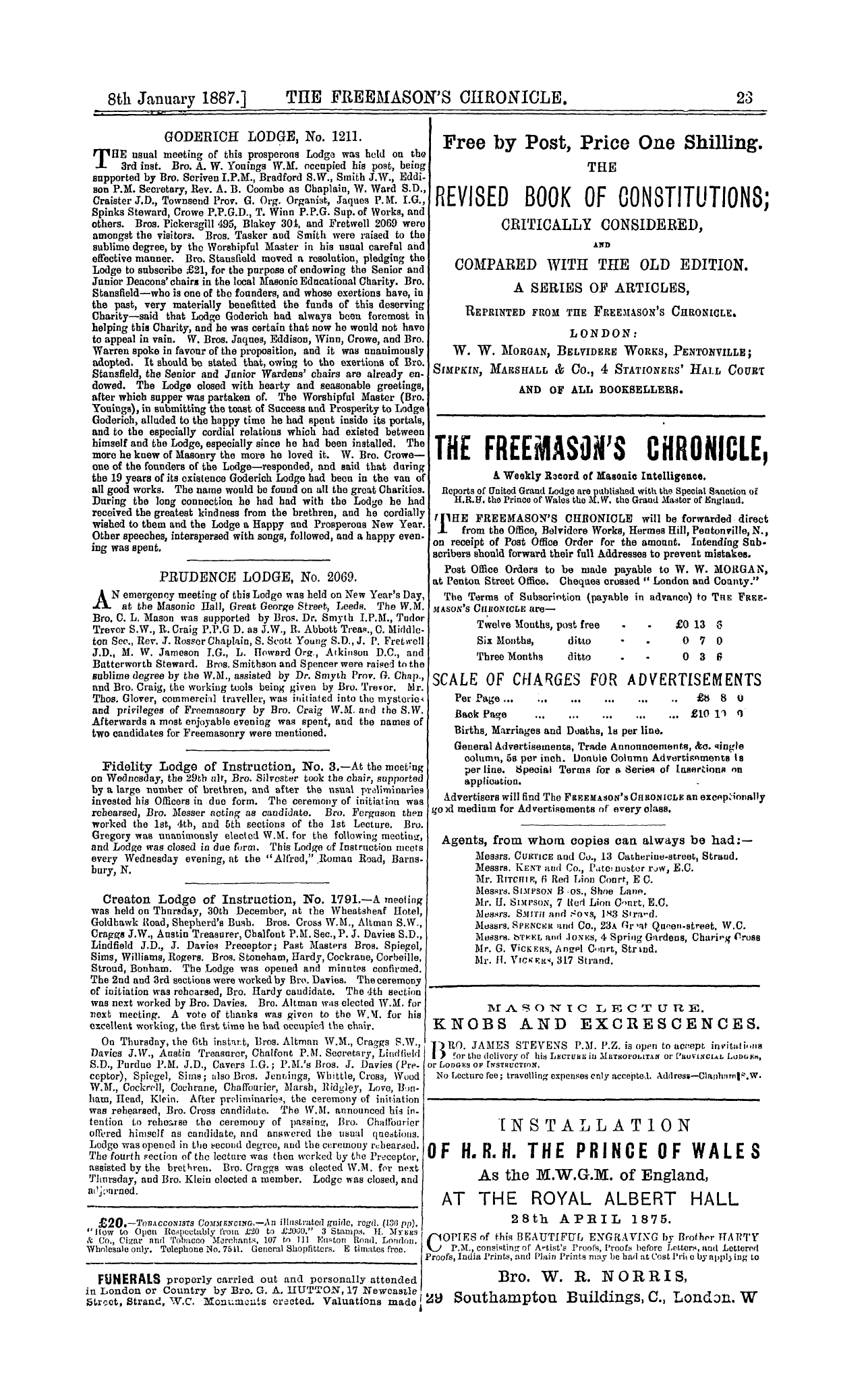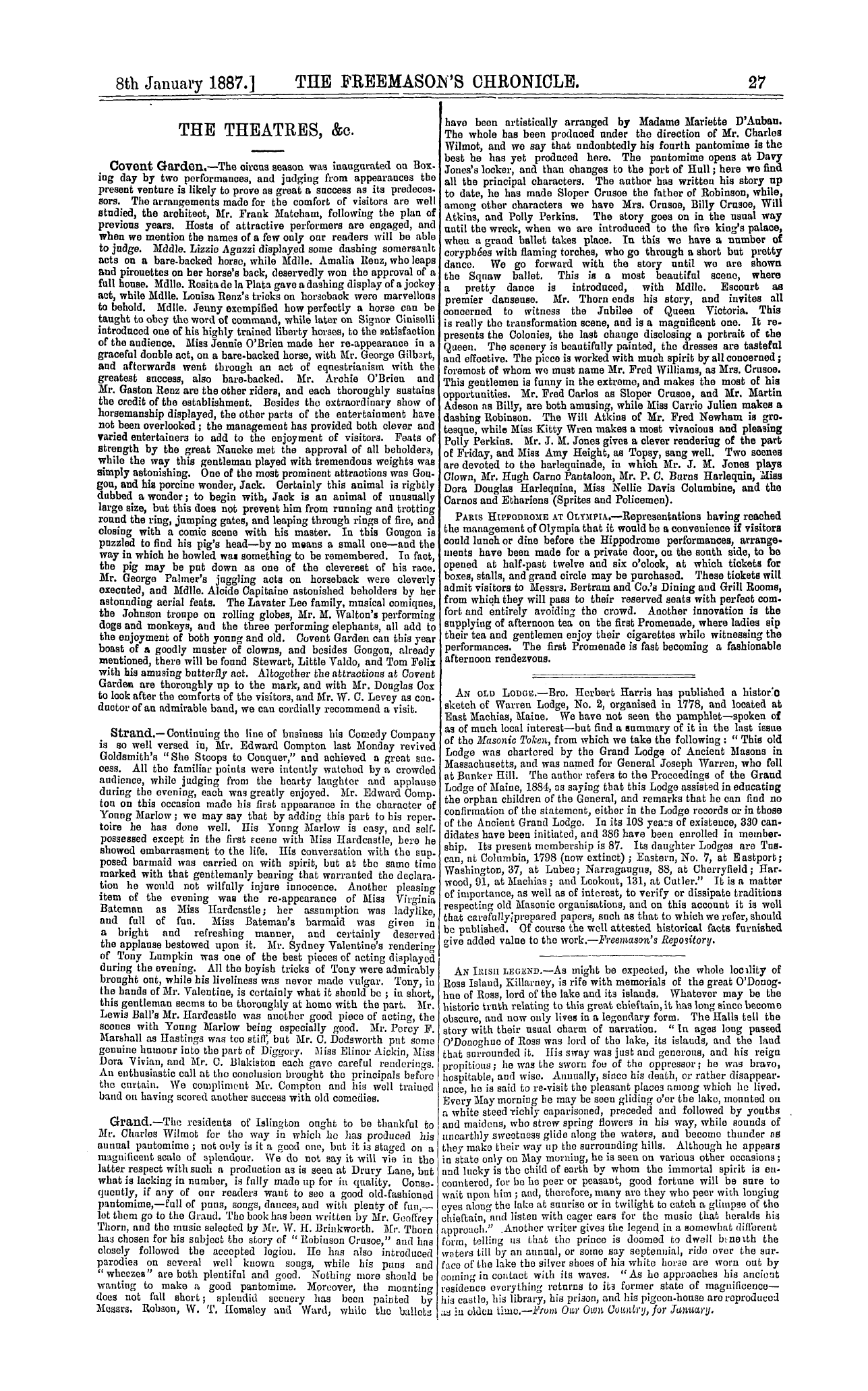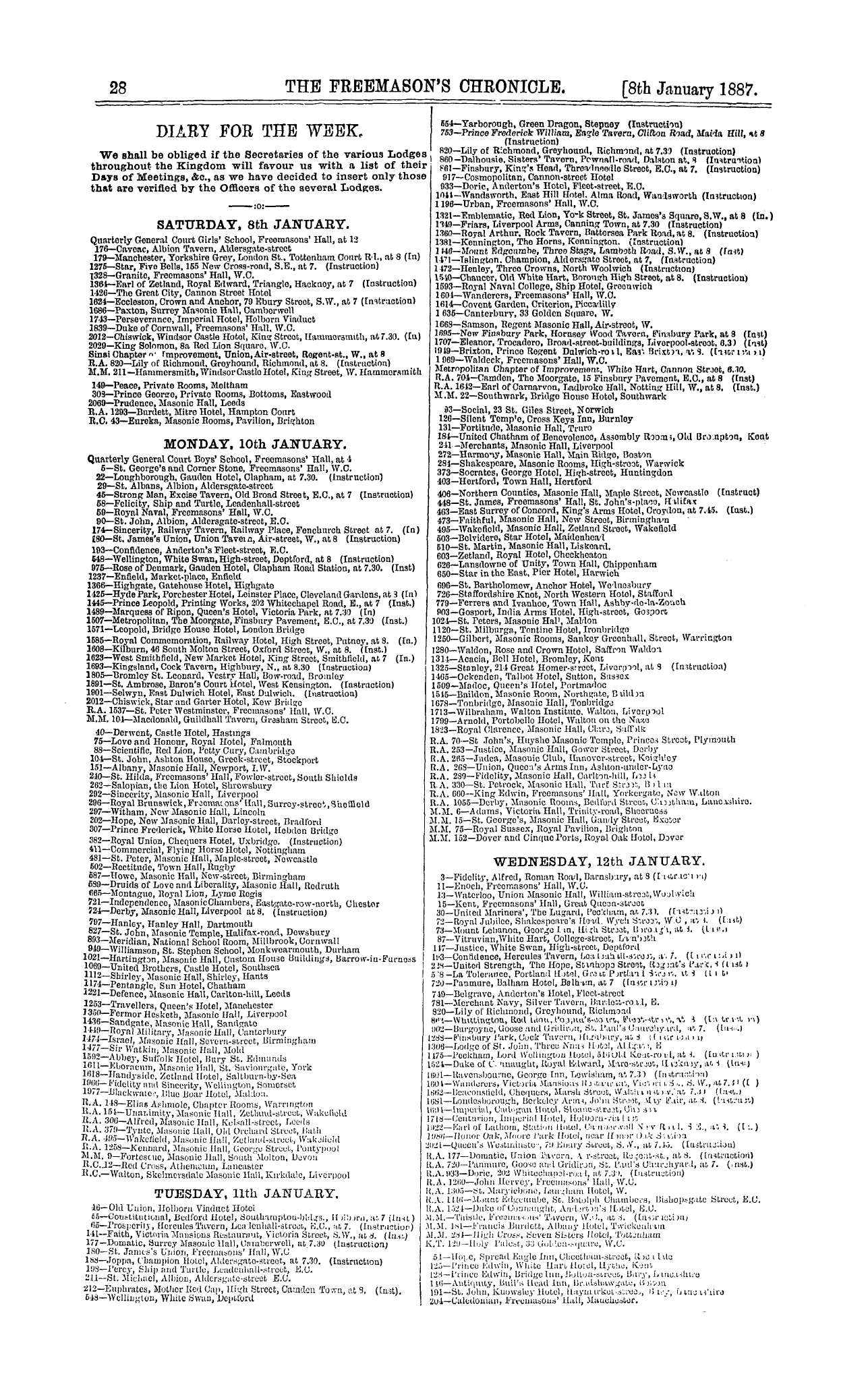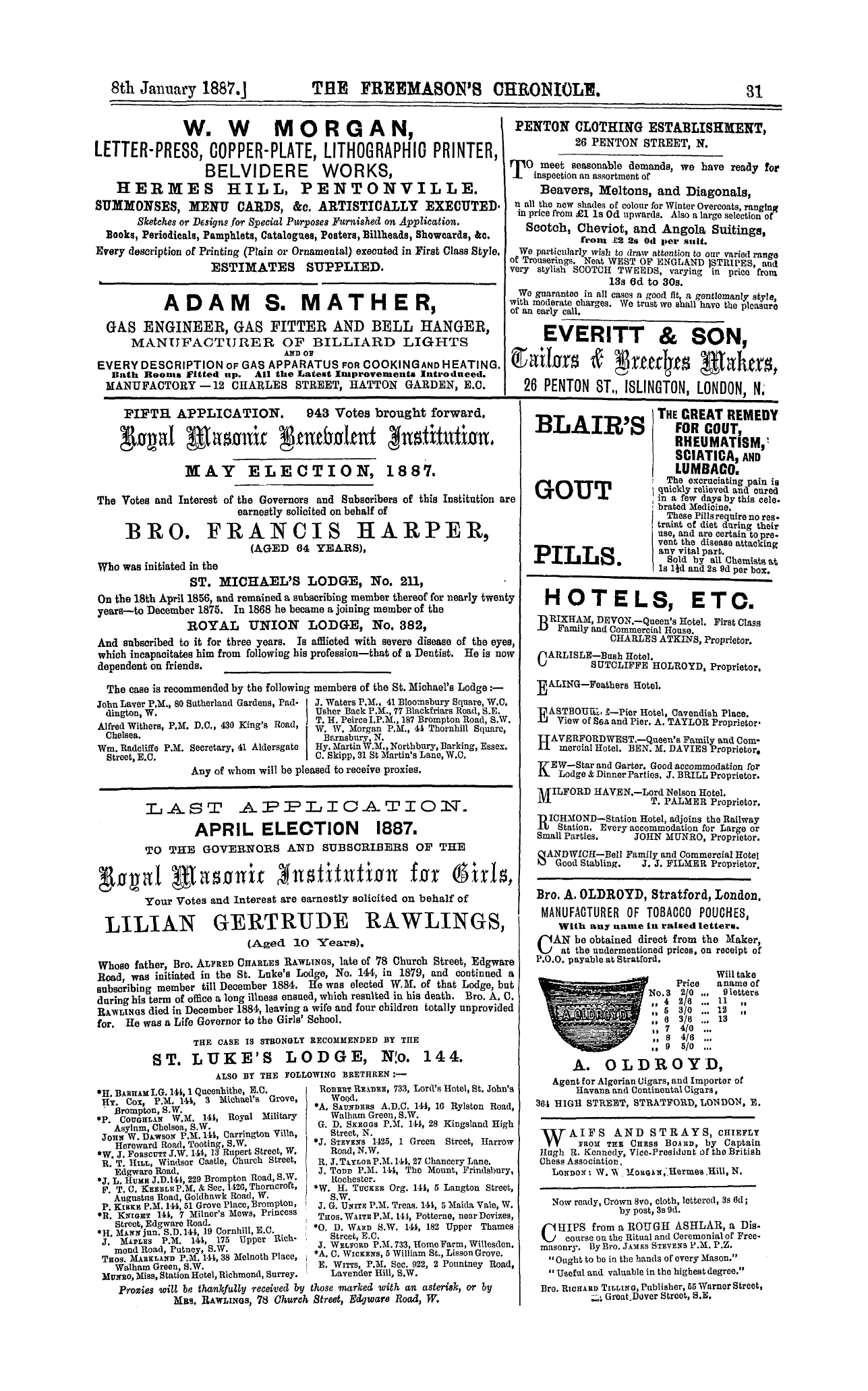-
Articles/Ads
Article MASONIC BENEVOLENCE IN 1886. ← Page 2 of 2 Article WHENCE FREEMASONRY CAME. Page 1 of 2 Article WHENCE FREEMASONRY CAME. Page 1 of 2 →
Note: This text has been automatically extracted via Optical Character Recognition (OCR) software.
Masonic Benevolence In 1886.
to enable the recipients to make a fresh start in life , we can form some opinion of tho amount of good which Freemasonry has accomplished ; but , as we have shown
above , the Charity of Freemasonry does not stop—it may be said only to commence—with the sums provided by the Fund of Benevolence . Much as thafc Fund has done in
the pasfc , and much as ifc is likely to do in tho future , its operations aro far exceeded by those of the three Charitable Institutions of the Craft , to each of which we mast award the highest praise , and for each of which we wish a long
period of increased prosperity . This prosperity can only arise , bo it understood , from the most strenuous efforts of the brethren enrolled under the banner of Freemasonry , to one and all of whom we again appeal for the utmost aid it
is possible for them to afford , In doing so we hope that the Charity Record of the current year will not only equal , but far excel , those whioh have preceded it .
Whence Freemasonry Came.
WHENCE FREEMASONRY CAME .
An Oration by Rigid Wor . Isaac Clements , Grand Orator , before the Grand Lodge of Illinois , 6 th October 1886 . ( Continued from page 4 ) .
WHERE did these men obtain their knowledge of the principles of working in brass and iron , and stone , and fine building , save from fche stores of wisdom obtained by Moses in Egypt , and by him imparted to their tribe during the journeys in the wilderness ? It has often seemed to me that the whole history of Israel , from the
time of Jacob to the time or feolomon , points to the Grand consummation of Mount Zion . That the long years of unrequited toil in Egypt ; the making of bricks without straw ; the working in iron , and brass , and bronze , and stone , was but fitting them by toil and discipline for
the work before them . Drilled and disciplined by labour and obedience they were ready for work . And the Levites , taught by Moses the principles of engineering , mathematics , philosophy and architecture learned b y him in Egypt , were ready to design and superintend the erection
of public works and public buildings in all their details , so that when the time for the erection of the temple , the masses being thus taught to work and accustomed fco discipline , and the Levites being so trained in the rules governing the erection of buildings , examining details ,
inspecting materials and superintending construction , the work could proceed . Bufc one thing was lacking : skilled in theory as were the workmen , and extensive as may already have been their experience in building , Solomon needed some one with more practical experience , more
educated skill , to superintend the finer and more delicate work in castings , mouldings , engravings and colourings . To the north-west of him lies the city and kingdom of Tyre , the fame of whose workmen had already reached Jerusalem . There is a traditional friendship between the
nations . Tho king of Tyre is the successor , and probable descendant , of one who as king of Egypt had befriended Joseph centuries before . Indeed , the wisdom of Joseph had saved both nations from destruction in that foreign land . Accordingly Solomon sends to Hiram , king of Tyre , for the needed help . Ifc is readilv granted . Ona
Hiram , a widow ' s son , a thoroughly practical , skilful man , comes and takes charge of the fine , intrinsic colourings , traceries and mouldings . Thousands of Tyrian workmen , skilled in hewing and cutting , go with Solomon ' s men into
the mountains of Lebanon for cedar , and into the quarries for stone , and the work moves smoothly and harmoniously on , because superintendents and builders have all been
taught in the same school of architecture , studied the game rules and been governed by the same principles—the rules and principles that had governed the best school of
architecture of that day , the architects and masons of Egypt a thousand years . Nor can it be doubted that here the same organisation and instruction of foremen and superintendents , thousands in number , as the Bible tells us , was requisite , as at the building of the Pyramids , and as is
required to-day . 1 or every one knows that no important or valuable building is erected in our times without a superintendent ' s office , where the foremen and overseers go for instruction . And , indeed , up to the time when Masonry became a purely philosophical institution , to which reference will soon be made , there is ample evidence
Whence Freemasonry Came.
that the Masonic corporations erecting public buildings had their Lodge-rooms and held their meetings in tho buildings , combining their instructions both in philosophic or symbolic Masonry and in their work . There can be no
doubt that such a Masonic Lodge existed at the temple during its erection , its existence being an absolute necessity . And here I doubt not was perfected and developed the organisation and the forms and methods adopted thafc have largely governed Masonry ever since .
Brethren , will any one say thafc there was not something of the divine ordering in this arrangement , whereby the descendants of the two men who jointly had ruled Egypt centuries before , and the two nations who had lived in
Egypfc as friends , should here meet on Mount Zion , in Palestine , and erect the first temple ever erected and dedicated to the one true ever-living Jehovah , God ? In distant Egypt , in far away India , in luxurious Babylon , temples , models of grace and beauty , glowing in oriental splendour and magnificence , had been long erected and
dedicated to the worship of their purely national gods . But here mid swinging censers and burning incense and chanting choirs ; here while the Shekinah descended and rested between the wings of the cherubim , and the cloud of God ' s glory filled the whole house : here , and now for
the first time m the world s history , was dedicated to the Almighty Jehovah , a temple , the grandest ever erected on earth . Fitting reward for the years of discipline and toil and drudgery in Egypfc . Grand consummation of the lessons learned and the friendships begun in distant Egypfc centuries before . And grander consummation for us as Masons , my brethren ; our traditions do meet and harmonise around the Masonic altar erected there .
Now , brethren , after examining our traditions , our symbols , our ceremonies , the historic evidence , the very necessities of tho case , can we not safely conclude that an organisation did exist in ancient Egypt with its secret ceremonies , initiations and degrees , having architecture and building as one of its special objects ? Thafc this
organisation , possibly modified by circumstances , can be fairly traced , flowing through two streams , down to the time of and uniting at the temple , and that at the building of the Temple of Solomon was organised and perfected in the work ? That this organisation was for the purpose of commemorating certain events that transpired there , and perpetuating the memory of the friendship between the two nations , the Hebrews and fche Tyrians ?
Up to this point , then , we certainly have reasonably safe footing . Masonic organisation certainly existed as indicated , But we are asked , what connection there can be between these ancient organisations of Operative Masons , engaged in the work of designing and erecting buildings ,
and our modern Freemasonry ? Let us see if we can trace any connection other than the resemblance heretofore
mentioned . Solomon ' s Temple was erected about one thousand years before Christ . Passing down the stream two hundred and fifty years , we find the work of building still going on at Jerusalem and Tyre . The temple is still standing ,
resplendent with its marble and gold and precious stones , the crowning glory of oriental architecture . Rome is founded . Numa Pompilius , one of its earliest rulers , became Emperor 715 years B . C . He fondly dreams that beneath thafc beautiful blue sky , in that glorious Italian climate , a city shall rise thafc will become mistress of the world . Her
manufactures shall surpass those of Tyre . Her commerce shall drive that of Phoenicia from the sea ; her temples and public buildings shall surpass anything ever known . With fche latter object specially in view , Numa determined ou a system of public buildings and public works of great grandeur and magnificence , embracing streets , roads , aqueducts , viaducts , palaces , temples and
other public buildings . In order that his plans might be successful , ifc became necessary to obtain the services of educated and skilled men from other nations . Accordingly he established two sets of corporations or colleges . The one was to be composed of architects and designers , and were called " Collegia
Fabwere given entire control of the public works . And in order to induce foreign artists to come to Rome and assist in the work , they were given certain privileges or freedoms nofc granted to other citizens . They were free from the necessity of worshipping the gods of Rome ; free from the
rorum . " Tho second , one hundred and thirty-two in number , were composed of educated workmen , practical builders , and were called " Collegia Artificum . " These two sets of Colleges were organized to work in harmony , and
Note: This text has been automatically extracted via Optical Character Recognition (OCR) software.
Masonic Benevolence In 1886.
to enable the recipients to make a fresh start in life , we can form some opinion of tho amount of good which Freemasonry has accomplished ; but , as we have shown
above , the Charity of Freemasonry does not stop—it may be said only to commence—with the sums provided by the Fund of Benevolence . Much as thafc Fund has done in
the pasfc , and much as ifc is likely to do in tho future , its operations aro far exceeded by those of the three Charitable Institutions of the Craft , to each of which we mast award the highest praise , and for each of which we wish a long
period of increased prosperity . This prosperity can only arise , bo it understood , from the most strenuous efforts of the brethren enrolled under the banner of Freemasonry , to one and all of whom we again appeal for the utmost aid it
is possible for them to afford , In doing so we hope that the Charity Record of the current year will not only equal , but far excel , those whioh have preceded it .
Whence Freemasonry Came.
WHENCE FREEMASONRY CAME .
An Oration by Rigid Wor . Isaac Clements , Grand Orator , before the Grand Lodge of Illinois , 6 th October 1886 . ( Continued from page 4 ) .
WHERE did these men obtain their knowledge of the principles of working in brass and iron , and stone , and fine building , save from fche stores of wisdom obtained by Moses in Egypt , and by him imparted to their tribe during the journeys in the wilderness ? It has often seemed to me that the whole history of Israel , from the
time of Jacob to the time or feolomon , points to the Grand consummation of Mount Zion . That the long years of unrequited toil in Egypt ; the making of bricks without straw ; the working in iron , and brass , and bronze , and stone , was but fitting them by toil and discipline for
the work before them . Drilled and disciplined by labour and obedience they were ready for work . And the Levites , taught by Moses the principles of engineering , mathematics , philosophy and architecture learned b y him in Egypt , were ready to design and superintend the erection
of public works and public buildings in all their details , so that when the time for the erection of the temple , the masses being thus taught to work and accustomed fco discipline , and the Levites being so trained in the rules governing the erection of buildings , examining details ,
inspecting materials and superintending construction , the work could proceed . Bufc one thing was lacking : skilled in theory as were the workmen , and extensive as may already have been their experience in building , Solomon needed some one with more practical experience , more
educated skill , to superintend the finer and more delicate work in castings , mouldings , engravings and colourings . To the north-west of him lies the city and kingdom of Tyre , the fame of whose workmen had already reached Jerusalem . There is a traditional friendship between the
nations . Tho king of Tyre is the successor , and probable descendant , of one who as king of Egypt had befriended Joseph centuries before . Indeed , the wisdom of Joseph had saved both nations from destruction in that foreign land . Accordingly Solomon sends to Hiram , king of Tyre , for the needed help . Ifc is readilv granted . Ona
Hiram , a widow ' s son , a thoroughly practical , skilful man , comes and takes charge of the fine , intrinsic colourings , traceries and mouldings . Thousands of Tyrian workmen , skilled in hewing and cutting , go with Solomon ' s men into
the mountains of Lebanon for cedar , and into the quarries for stone , and the work moves smoothly and harmoniously on , because superintendents and builders have all been
taught in the same school of architecture , studied the game rules and been governed by the same principles—the rules and principles that had governed the best school of
architecture of that day , the architects and masons of Egypt a thousand years . Nor can it be doubted that here the same organisation and instruction of foremen and superintendents , thousands in number , as the Bible tells us , was requisite , as at the building of the Pyramids , and as is
required to-day . 1 or every one knows that no important or valuable building is erected in our times without a superintendent ' s office , where the foremen and overseers go for instruction . And , indeed , up to the time when Masonry became a purely philosophical institution , to which reference will soon be made , there is ample evidence
Whence Freemasonry Came.
that the Masonic corporations erecting public buildings had their Lodge-rooms and held their meetings in tho buildings , combining their instructions both in philosophic or symbolic Masonry and in their work . There can be no
doubt that such a Masonic Lodge existed at the temple during its erection , its existence being an absolute necessity . And here I doubt not was perfected and developed the organisation and the forms and methods adopted thafc have largely governed Masonry ever since .
Brethren , will any one say thafc there was not something of the divine ordering in this arrangement , whereby the descendants of the two men who jointly had ruled Egypt centuries before , and the two nations who had lived in
Egypfc as friends , should here meet on Mount Zion , in Palestine , and erect the first temple ever erected and dedicated to the one true ever-living Jehovah , God ? In distant Egypt , in far away India , in luxurious Babylon , temples , models of grace and beauty , glowing in oriental splendour and magnificence , had been long erected and
dedicated to the worship of their purely national gods . But here mid swinging censers and burning incense and chanting choirs ; here while the Shekinah descended and rested between the wings of the cherubim , and the cloud of God ' s glory filled the whole house : here , and now for
the first time m the world s history , was dedicated to the Almighty Jehovah , a temple , the grandest ever erected on earth . Fitting reward for the years of discipline and toil and drudgery in Egypfc . Grand consummation of the lessons learned and the friendships begun in distant Egypfc centuries before . And grander consummation for us as Masons , my brethren ; our traditions do meet and harmonise around the Masonic altar erected there .
Now , brethren , after examining our traditions , our symbols , our ceremonies , the historic evidence , the very necessities of tho case , can we not safely conclude that an organisation did exist in ancient Egypt with its secret ceremonies , initiations and degrees , having architecture and building as one of its special objects ? Thafc this
organisation , possibly modified by circumstances , can be fairly traced , flowing through two streams , down to the time of and uniting at the temple , and that at the building of the Temple of Solomon was organised and perfected in the work ? That this organisation was for the purpose of commemorating certain events that transpired there , and perpetuating the memory of the friendship between the two nations , the Hebrews and fche Tyrians ?
Up to this point , then , we certainly have reasonably safe footing . Masonic organisation certainly existed as indicated , But we are asked , what connection there can be between these ancient organisations of Operative Masons , engaged in the work of designing and erecting buildings ,
and our modern Freemasonry ? Let us see if we can trace any connection other than the resemblance heretofore
mentioned . Solomon ' s Temple was erected about one thousand years before Christ . Passing down the stream two hundred and fifty years , we find the work of building still going on at Jerusalem and Tyre . The temple is still standing ,
resplendent with its marble and gold and precious stones , the crowning glory of oriental architecture . Rome is founded . Numa Pompilius , one of its earliest rulers , became Emperor 715 years B . C . He fondly dreams that beneath thafc beautiful blue sky , in that glorious Italian climate , a city shall rise thafc will become mistress of the world . Her
manufactures shall surpass those of Tyre . Her commerce shall drive that of Phoenicia from the sea ; her temples and public buildings shall surpass anything ever known . With fche latter object specially in view , Numa determined ou a system of public buildings and public works of great grandeur and magnificence , embracing streets , roads , aqueducts , viaducts , palaces , temples and
other public buildings . In order that his plans might be successful , ifc became necessary to obtain the services of educated and skilled men from other nations . Accordingly he established two sets of corporations or colleges . The one was to be composed of architects and designers , and were called " Collegia
Fabwere given entire control of the public works . And in order to induce foreign artists to come to Rome and assist in the work , they were given certain privileges or freedoms nofc granted to other citizens . They were free from the necessity of worshipping the gods of Rome ; free from the
rorum . " Tho second , one hundred and thirty-two in number , were composed of educated workmen , practical builders , and were called " Collegia Artificum . " These two sets of Colleges were organized to work in harmony , and















